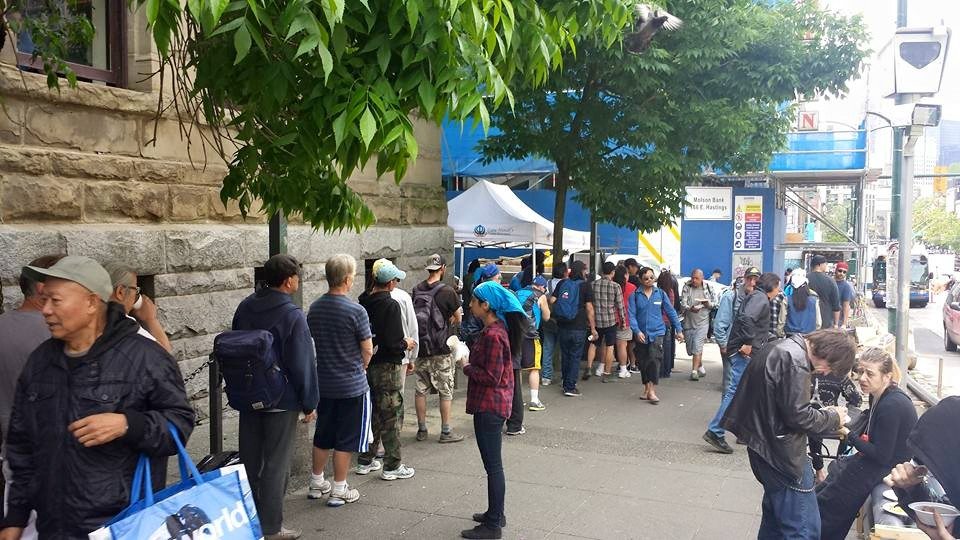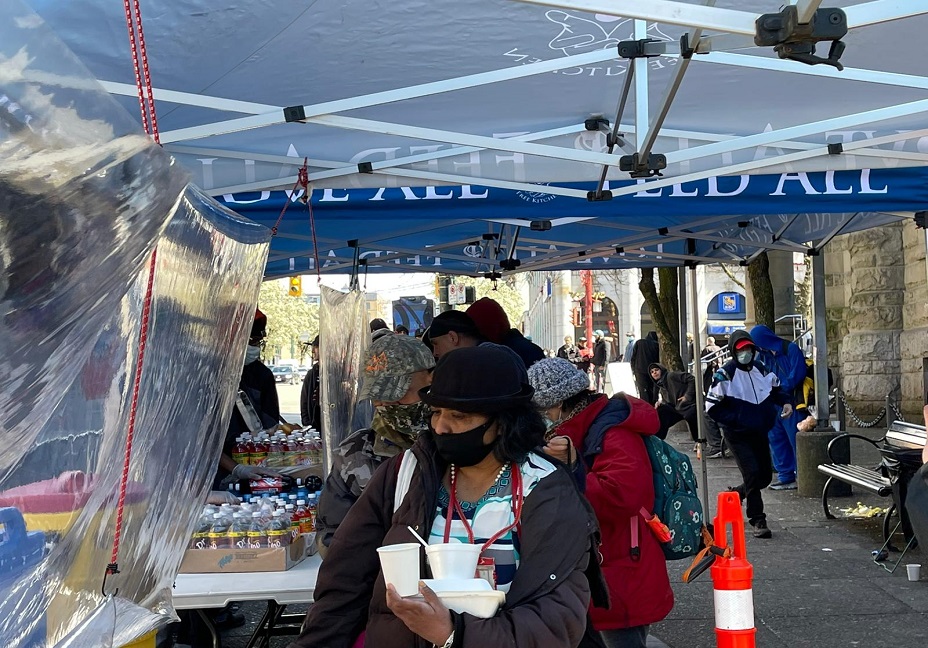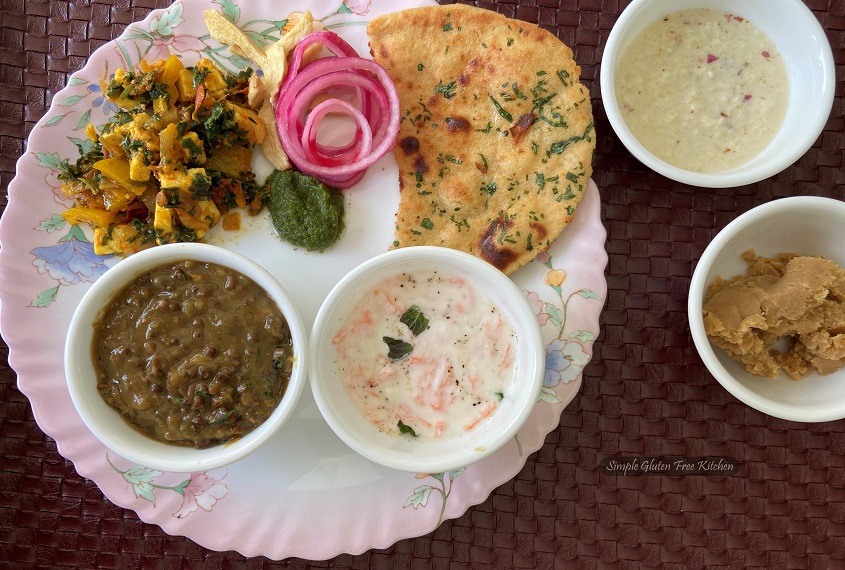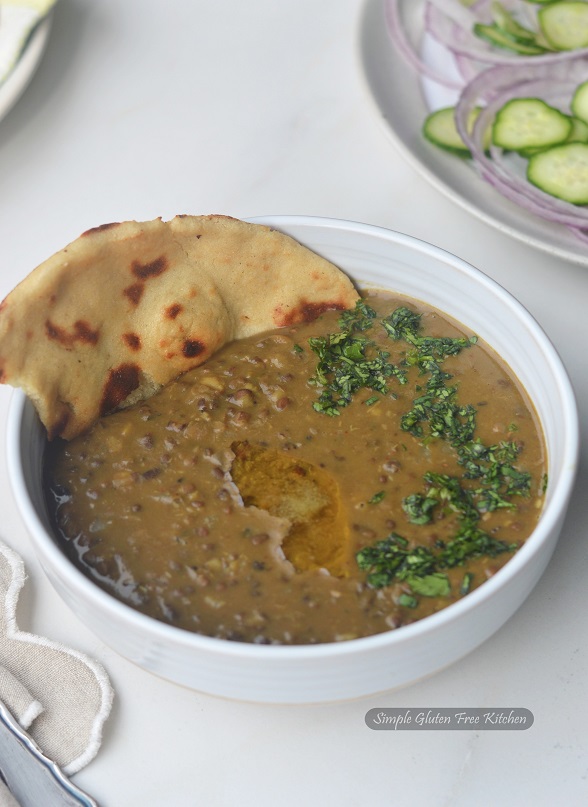If you have been to a Gurudwara and have had Langar, then you know that there is no Daal in the whole world tastier than “langar waali daal”. It is known with different names, such as gurudwara waali daal (lentil dish that is cooked in a Sikh temple), manh choleyan di daal or Amritsari daal. It can be made with a combination of different types of lentils but more commonly a mix of manh (whole urad aka black lentil) and small portion of Cholleyan di Daal (split bengal gram) is used. Hence when cooked at home it is called, “Manh Cholleyan di Daal” but not langar waali daal. Sikhs do not refer to the regular food cooked in the home kitchen as langar unless we are hosting a religious service in our home.
To see the recipe in action, watch my video on YouTube.

Some may confuse langar waali daal with the other popular daal variant “Daal makhani” but this recipe is completely different with its own unique taste. Daal makhani, is made with black lentil and kidney beans which yields a different taste altogether and has toamotes. A traditional gurudware waali daal is prepared with minimal ingredients and without the tomatoes to keep it fresh for longer in all weather. After reading my post I can guarantee that you can recreate this simply soulful and delicious langar waali daal at home and vouch for its taste yourself.
But before going over to the recipe, let me explain about langar or Guru ka langar.
The term ‘langar’ refers to the food served at a Gurudwara (Sikh place of worship). Sure, any place where food is given can be called Langar but every such langar cannot be called ‘Guru ka Langar’. In Sikhism, Guru ka Langar is run in the name of Guru. This concept is as old as Sikhism. It was started by Guru Nanak, the first of the 10 Sikh gurus, the tradition was imbibed and honored by all his successors. In fact, it was the third Guru that made it compulsory for all people, rich or poor, male or female, all sit in the same pangat (meaning rows or lines) to share and enjoy the food together. Its purpose was to support equality amongst all in the times when inequality was prevalent in medieval India. In Sikh philosophy, people need physical nourishment before the spiritual, and by feeding whoever comes through the doors, the langar creates a true sense of unity. Hence, every gurdwara has a community kitchen that serve vegetarian meals to all, Sikh and non-Sikh alike.
Although Sikhs are not required to be vegetarian, only vegetarian food is served so that there are no barriers for anyone, whether they be religious or dietary. Sikhs regularly donate food to the gurdwara, which volunteers cook in massive pots to make sure that no-one leaves hungry. Strict rules of hygiene and cleanliness are important when preparing the Langar (i.e., washed hands, never tasting it while cooking).
Some gurudwaras also serve langar on the streets to ensure it reaches those that may need it most. Guru Nanak’s Free Kitchen, a Sikh-based organization serves hot vegetarian meals every Sunday in Vancouver’s Downtown Eastside. The meals are usually comprised of rice, roti wraps, daal (lentil) or cholay (chickpeas), kheer (Indian rice pudding), and cha (Indian tea). It’s run by volunteers so it’s seen as a privilege to help run it – whether it’s cooking, cleaning, or serving the food.

A glimpse of long lines waiting for langar at Downtown East Side Vancouver
Image courtesy: Google Images
Depending on the Gurdwara, the meal times and availability of langar changes. Some dishes, such as daal, roti and sabzi are cooked daily for lunch and dinner, while others, such as curries, and sweets that are fried in ghee would be reserved for festivals or special occasions. If you go around 3- 5 PM you might get fritters and ladoos with tea. So, there is always something available, even late at night. The food though is simple and not a feast but it gives you the satisfaction that no five-star restaurant food can ever give you. The taste comes from the way it is prepared with love and simran (remembering God by reciting prayers) of the volunteers cooking. The food is first fed to god and later served to people, a common practice not only in Sikh but also in Hindu temples.

My friend sent me this picture. Her son volunteers in Guru Nanak Free Kitchen every Saturday.
There is usually a waiting list of people who want to provide the langar each week. This is because they want to serve God, and by helping others they feel they are doing seva (selfless service). So, you see langar is not just a free meal it is the foundation of the Sikh faith. The seva is not limited to the gurudwaras. Sikhs donate generously to food banks and at other places. When Covid 19 happened Gurudwaras collected blankets, jackets, socks, mattresses, and groceries to give it to international students and others who were stuck at home.

Now, since we all have been social distancing, the Vaisakhi parade has been put on hold for the second year in a row, Gurudwaras are still closed for sangat (sikh congregation) and langar, and there are no in person gatherings at home, I thought to share the recipe of langar waali daal so that you could try it in your kitchen. This rustic and simple daal is outrageously delicious and doesn’t even require the popular ingredients, like cumin seeds, garam masala, tomatoes, and the extra tadka and is a great example of how you can create something amazing out of simple ingredients.
The nice thing about this daal aside from the fact that it’s delicious, is that it is super easy and can be a great recipe for beginners. What gives this daal the depth and flavor is the slow cooking process with desi ghee in it. If you don’t have ghee you can substitute butter. Just to let you know you can make ghee yourself without much trouble and I have a recipe posted here.
When you are ready to cook, the soaked lentils go in the instant pot along with onion, ginger, garlic, desi ghee and the basic seasoning. You can adapt this daal to your own taste by adding extra ingredients but then it won’t be langar style daal any more. The daal gets cooked in the instant pot to tender perfection in under 3 hours (including wait time). And while it is cooking you can do other things in the kitchen. If you don’t have an Instant Pot, no problem! You’ll have to remember to soak the lentils overnight to shorten the cooking time on stove and use more water to ensure it doesn’t dry out. I know people say lentils don’t need to be soaked but not all lentils are equal. The whole urad does need to be soaked beforehand if you’re going the stovetop and instant pot route. This daal tastes much better when refrigerated and heated again the next day.
If you are wondering whether you can cook this daal in a slow cooker, sure, you can (I have the slow cooker directions below as well). In winters I always cook up a double batch in the slow cooker and then freeze half of it in portions. It holds up really well in the freezer and saves so much time for busy days. You will need to add water when you reheat to get back the original consistency and may also have to adjust the seasoning.

This daal is usually served thicker, like in the photos so you can scoop up with roti. Besides that, I serve a simple onion salad and yogurt on side for a seriously body and soul satisfying meal. But if you are not a roti fan you can always serve with rice and can also make it thinner to enjoy a bowl of this daal just like a soup.
So, go ahead and give this langar waali daal a try, if you do try make sure to leave a comment. You are welcome to take a picture and share it with me using the hashtag #simpleglutenfreekitchen. I am on Facebook, Twitter, Instagram, Pinterest, and also You Tube. Let’s stay in touch.
Langar waali daal is a very rustic and simple dish cooked minimal ingredients but with lots of love.
Ingredients
- 3/4 cup manh / whole urad (black lentils), soaked for 6 hours (overnight is best)
- 1/4 cup cholleyan di daal / chana daal ( split and skinned bengal gram), soaked for 6 hours
- 3/4 tsp turmeric powder
- 2 -3 green chilies
- 3/4 tsp red chili powder
- Salt to taste
- 1 tbsp desi ghee
- 1 onion, chopped (about 3/4 cup)
- 1" piece ginger
- 4-5 garlic cloves
- 4 cups water
- desi ghee
- chopped cilantro
Instructions
- Pick the lentils for any impurities, like small stones or other debris.
- Rinse them thoroughly, until the water runs clear.
- Soak them at least for 6 hours or overnight.
- Chop onion. Pound ginger, garlic and green chilies in a mortar.
- Drain and rinse the soaked lentils, then add to instant pot.
- Next, add the onions, ground ginger, garlic and chilies, desi ghee, salt, turmeric and red chili powder. Cover with 4 times water.
- Close the lid and turn the valve to a Sealing position.
- Press the "Pressure Cook" or "Manual" button and set the time to 45 minutes on High pressure.
- When the Instant Pot is done cooking, let the pressure release naturally.
- Carefully open the lid and give the lentils a stir.
- Turn on the Instant Pot on 'normal' sauté and bring it to boil.
- Once it comes to boil select 'less' on sauté. Add more water (preferably hot) if the water level gets near the level of lentils.
- Simmer for 30 -45 minutes, stirring occasionally (The amount of time your lentils need to cook will vary depending on their age and soaking time).
- Serve hot with roti, naan, or rice.
- Place all the ingredients (manh, cholleyal di daal, salt, turmeric, red chili, chopped onion, desi ghee, and ginger garlic green chili paste) in slow cooker. Add 7 cups water.
- Put the lid on and cook on a high setting for three hours and then on low for 9 hours.
- After 12 hours the dal will be perfectly soft and creamy.
- Transfer daal to a serving bowl, garnish with cilantro.
- Add desi ghee on top while serving.
Notes
Soaking time is not included in the prep time.
The recipe is also available on video *here*

angiesrecipes
The dal looks so tasty and I prefer it with roti.
I didn’t expect that it required 45 mins to pressure cook though, esp. after 6-hr-soaking. Don’t black lentils and skinless dal cook very fast?
Balvinder
Hi Angie,
No, these black lentils take time to cook. I hope you are not mistaking it for beluga lentils which only take 20 minutes to cook. But If you are in a hurry you can make this daal, using both the lentils in split form.
Breadandsalt
Very nice site! Thank you for providing this site. We cook green and red lentils dishes or soups alot. But so far i have not tried black lentil. It must be delicious. Happy day.
Balvinder
The black lentils which we call “Urad” is the most delicious lentil, more than red lentil, if i say so.
Raymund
That dal looks good! I will definitely have some extra naan with that
evi erlinda
This daal looks so tasty and flavorful!
I will learn how to cook it, it is so appealing!
Thank you, Balvinder.
John / Kitchen Riffs
Love lentils, and this dish is a lentil festival. Really interesting recipe — thanks.
sherry
lentils are lovely:) i know of the tiny french lentils which are quite dark, but not black ones. amazing how many kinds there are. they do add a wonderful texture and taste to food, don’t they? thanks for the interesting info about the foods. hope you’re keeping well.
cheers
sherry
Judee
Such an interesting post and delicious recipe. I have a bag of black lentils just waiting to be used.
Laura
This dal sounds so tasty, Balvinder! I love the chiles and spices included! I love the idea of making it in the Instant Pot, too!
Easyfoodsmith
Langar ke khaane ka swaad alag hi hota hai, fir chahe woh dal ho ya fir kadah prashaad.